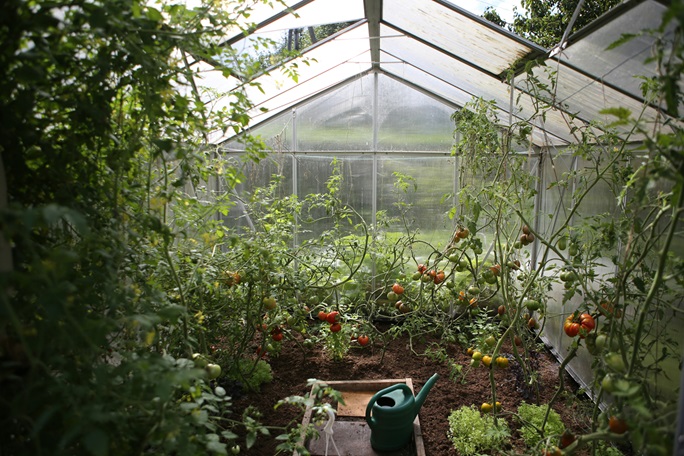Besides being an eco-friendly initiative, greenhouses are a haven of safety for plants, so they’re a great option if you’re considering them for your home garden.
Greenhouse plants grow stronger and healthier because of the controlled environment that creates ideal growing conditions. Most importantly, greenhouses allow you to garden all year round with a strategic approach.
5 Basic Elements for an All-Year Greenhouse
By allowing you to grow more with less stress and energy, you can create a self-sufficient and naturally abundant greenhouse. Here’s how:
- Southward Orientation: Since the sun is the primary source of heat for those in the northern hemisphere and comes from the south, place your light-capturing material facing southward. Add growth lighting if needed.
- Insulate Everywhere: Since a greenhouse’s main function is to capture energy, retaining it is crucial. Add insulation on every surface, especially the north-facing wall. Avoid glazing.
- Underground Insulation: Install insulation around the perimeter of the greenhouse and line it with a below-grade waterproof membrane to protect the underground structure; this air pocket insulates the soil underneath.
- Controlling Heat and Light: The sun’s angle changes during the seasons, i.e., it is low during winters and much higher during summers. Keep south-facing walls angeled to absorb most light and use high-transmittance material on vertical surfaces.
- Natural Ventilation: Moving air ensures plants grow strong and prevents pathogens, insects, and molds. Place vents higher to create a path of least resistance and to ensure natural convection facilitates airflow without added energy.
A Seasonal Approach To Greenhouse Gardening
While the seasonal approach requires consistent adjustments, it pays off for all-year plant growth.
Garden Prep In Spring
Every garden’s time for summer prep and rejuvenation starts during spring, even for greenhouses. Ensure your greenhouse is growing season-ready by following this five-step process:
- Deep clean the area and polycarbonate panels to maximize light penetration. Clear out debris and sanitize all surfaces to keep pests and diseases away.
- Prep the soil by airing it out and adding compost to ensure a nutrient-dense base for healthy plants.
- Increase airflow because of the warm weather by opening vents and adding fans.
- Inspect the irrigation system for blockages and leaks so you can water your plants efficiently.
- Start planning for summer by planting seedlings, which will produce lush growth. By the time the heat kicks in, they will produce lush growth.
Growing Produce In Summer
The heat comes with specific advantages and challenges for summer greenhouse gardening, so here’s a checklist on how you can build a plant-friendly environment:
- ⬥ Water frequently or consider automated watering systems.
- ⬥ Stay vigilant and do regular checks for warmth-loving pests and diseases.
- ⬥ Use shade cloths or a temperature control system to avoid heat-stressed plants.
- ⬥ Fertilize well because summer is a high-growth period and requires additional nutrients.
- ⬥ Plan for fall by considering crop rotation to restore nutrients in the soil.
Transitioning In Fall
Like springtime, fall is another season during which you should maintain regular checks. You need to transition and prepare for colder months, so inspect the heating system to ensure it’s functioning correctly. Similarly, check for overgrown foliage or insulating materials that may obstruct the light.
Clean and organize your greenhouse by removing pruning plants, removing debris, and removing diseases or dead plants. Insulate the area well; seal gaps using insulation or bubble wrap. Plan for winter by selecting plants that thrive in the cold.
Care In Winter
Garden care during cold months is a top priority, especially in the heart of winter. While you may not see abundant growth, the extreme conditions require a more protective approach. Always check the insulation and heating systems to avoid freezing your plants.
You must monitor plant health and watch out for signs of stress due to cold or lack of light. This is also when you review your entire year’s experience and what worked or didn’t work well. Create a plan for crop rotation, introduce new plant varieties, and invest in infrastructural improvements.
Parting Thoughts
Setting up a year-round greenhouse at home can transform your gardening experience. Planning, designing, and using suitable materials allows you to grow different plants regardless of season. By following this guide, you’ll have a successful, high-producing greenhouse that is healthy throughout the year.
5 Green Gardening Tips for a Better Harvest


